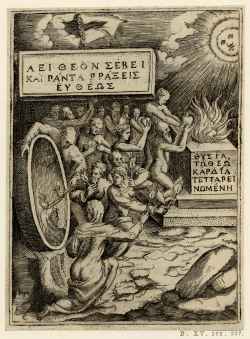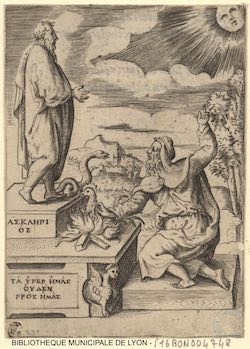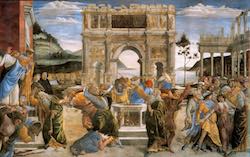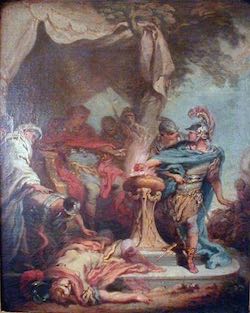Topic: 2. Sacrifice and religion: Comparisons, Antiquarians, Anthropology (16th-18th Century)
Religious sacrifices across various cultures and contexts sparked widespread interest in Early Modern Europe. As Christianity expanded into regions inhabited by "infidels" and "pagans", Europeans encountered a diverse array of sacrificial customs, ranging from the Sati rituals in India to the Aztec sacrifices in the Americas. This cross-cultural exposure captivated a wide audience, including theologians, philosophers, political thinkers, antiquarians, orientalists, missionaries, poets, artists, and even the general public. These encounters broadened the European understanding of sacrifice and led to a critical reassessment of classical and biblical sacrificial rites. This section includes:
- Sources: A selection of early modern printed materials, which include descriptions of the Americas, Asia, and Africa, alongside antiquarian and philological studies on religious sacrifice in classical antiquity and beyond. It also presents early modern works of ethnological observations and the first attempts to compare different sacrificial practices in various traditions and contexts, laying the groundwork for disciplines like the history of religions and anthropology.
- Iconographic Representations: A rich collection of images from the 16th to 18th centuries, illustrating a range of sacrificial rituals and practices as seen in different cultural and geographical contexts.
- Related Bibliography: An extensive bibliography spanning scholarly works from the 19th to 21st centuries, providing contemporary analyses and interpretations of these early studies and observations.
People lighting torches from a concave mirror reflecting the sun and worshippers offering their hearts. Emblems of Achilles Bocchius. (1555)
from: Bologna
The British Museum, London
Sacrifice of a rooster to Asclepius (16th Century)
Bibliothèque municipale, Lyon
Sacrifice et sorcellerie. L’économie morale de l’aumône au Sénégal
in: Annales: Histoire, Sciences Sociales, v. 69 (2014), issue 2: pp.471-504.
L'armatura de' forti ovvero memorie spettanti agli infedeli ebrei che siano o turchi
Rome: Paolo Giunchi, 1794.
Le sacrifice humain en Grece ancienne
Athènes - Liège: Centre international d'Etude de la religion grecque antique, 1994.
Quand le rite devient technique. Sacrifice et abattage dans le monde musulman
in: Techniques & Culture, v. 21 (1993), issue : pp.79-96.
Retour sur ‘Quand le rite devient technique’
in: Techniques & Culture, v. 54-55 (2010), issue : pp.547-561.
Symboliques et rituels de la protection. Le sacrifice tcargîba dans la société maure
in: Sacrifices en Islam: Espaces et temps d'un rituel, pp. 239-261
: , 1999.
Self-Sacrifice and Human Sacrifice in Soyinka's Death and the King's Horseman
in: Research in African Literatures, v. 19 (1988), issue 4: pp.529-550.
Sacrifice to Priapus [1537 - 1555]
Rijksbureau voor Kunsthistorische Documentatie, Den Haag
Incorporating Mesoamerican Cosmology within a Global History of Religion. Some Considerations on the Work of Lorenzo Pignoria
in: Reshaping the World: Debates on Mesoamerican Colonial Cosmologies, pp. 70-99
Boulder: University Press of Colorado, 2020.
Abraham in Judentum, Christentum und Islam
Göttingen: Vandenhoeck & Ruprecht, 2009.
Mucius Scevola in front of Porsenna (18th Century)
Musée de l’Hôtel Sandelin, Saint-Omer
Des animaux et de leur traitement selon le judaïsme, le christianisme et l’Islam
in: Studia Islamica, v. 9 (1958), issue -: pp.31-48.
Confounding Blood : Jewish Narratives of Sacrifice and Violence in Late Antiquity
in: Ancient Mediterranean Sacrifice, pp. 265-286
Oxford: Oxford University Press, 2011.
Le Sacrifice d'Orphée
Paris: Jouve, 1926.
Tales from Trent: The construction of “Saint” Simon in Manuscript and Print, 1475-1511
in: The Saint between Manuscript and Print: Authors, editors, publishers, readers and the phenomena of sanctity on the Italian peninsula, 1300-1600, pp. 185-215
Toronto: University of Toronto Press, 2015.
Abdul Qadar and the sheep of ʿId al-Adha
in: Everyday life in the Muslim Middle East, pp. 274-275
Indiana: Indiana University Press, 2014.






